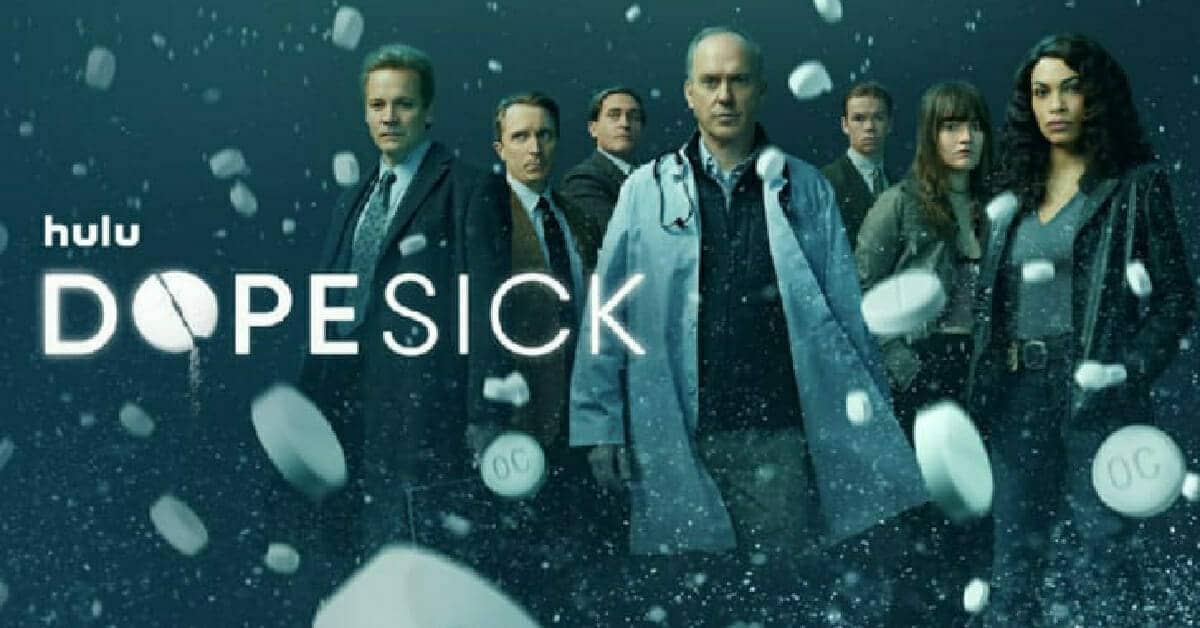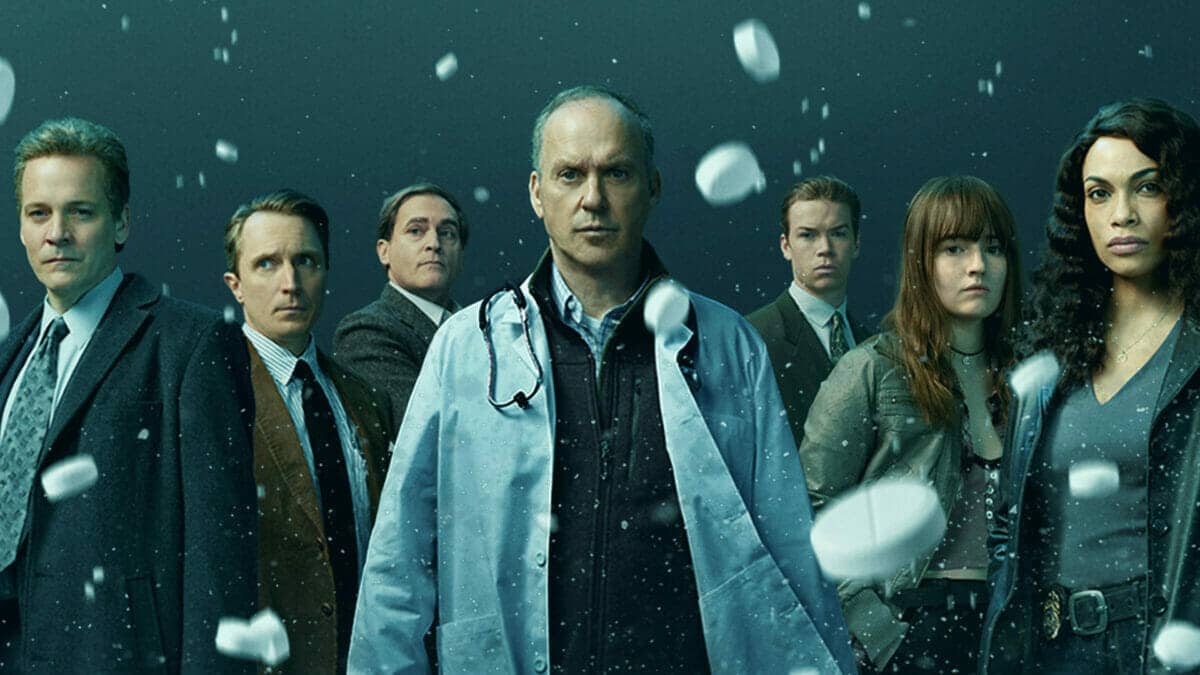
Dopesick examines how one company triggered the worst drug epidemic in American history. The series takes viewers to the epicenter of America’s struggle with opioid addiction, from the boardrooms of Big Pharma to a distressed Virginia mining community to the hallways of the DEA. Defying all the odds, heroes will emerge in an intense and thrilling ride to take down the craven corporate forces behind this national crisis and their allies. This limited-time series is inspired by Beth Macy’s New York Times bestselling book.
Sober Curator Prop Tip: Dear Readers…Grab your Kleenex and your stress ball before settling in. After speaking with many friends in recovery, many have found this series incredibly triggering. A few even had to stop watching it. Please proceed with caution.
Is Dopesick a true story?
Yes. Well, mostly. Hulu’s limited series is based in part on material from the nonfiction book Dopesick: Dealers, Doctors, and the Drug Company that Addicted America by Beth Macy. Based on reports I’ve read on the internet, including NPR, extensive research was done to give the series a very relatable depiction. People from small towns who have gone through opioid abuse disorder were brought into an interview. Not to my surprise, it’s also reported they consulted with a doctor who was once addicted to OxyContin. Many characters depicted in this series were fictional. The personalities and traits of several characters were reported to be a mixture of stories from various real-life people.
As for the members of the Sackler family, who own and control Purdue Pharma, the manufacturers of OxyContin, I can’t imagine much was dramatized there. Learning how this family operated shook me to my core. Especially after listening to the book Empire of Pain: The Secret History of the Sackler Dynasty by Patrick Radden Keefe. After watching the first three episodes of Dopesick, I drove headfirst into 18 hours of this sickening content on Audible. Horrified by the details I was learning, I couldn’t get enough. (In my case, you can take the girl out of the addiction, but you can’t take the addiction out of the girl.)
How I related to the timeline
Seven of the eight episodes jump around between the years of 1996 and 2006. These are significant years for me. My son was born in 1996, and I got sober in 2006. The bulk of my alcohol and drug abuse, which included OxyContin, was during this decade. It was only in episode 8, the finale, that the story brought us almost to the present day (2019). Additionally, I grew up in a small logging town in Washington State. And while that’s not exactly the same as a mining town in the Appalachian Mountains of Virginia, it felt pretty similar to me.
How I related to the storyline
Setting aside the prominent part of being addicted to OxyContin, there were many other parts of the storyline and characters I felt connected with. In some regards, I felt connected to Betsy, who Kaitlyn Dever played. She was a simple, small-town girl, living with her ultra-religious parents and a hard worker. What started as a solution to pain management from a job injury turned into something incredibly dark and vicious.
The storyline that left a lump in my throat that feels like it’s still there was the sales and marketing tactics used by Purdue Pharma. Considering my entire adult career has been in sales and marketing, I was both fascinated and repulsed at the manipulation of the facts and sales tactics that were demonstrated. I also couldn’t stop feeling that I would have crushed it at that sales job. But then I’d remind myself it’s more likely it would have killed me. Especially if I had such easy access to the pain medication. During that decade of my life, more was never enough.
I also identified with the DEA agent Bridget Meyer, who Rosario Dawson played. While I’ve never been in the same line of work, her addiction to the cause of taking Purdue Pharma tracked with me. In my 30s, after getting sober, I became a full-blown workaholic, trading in one addiction for another. I sure didn’t realize it at the time because, much like Bridget, I thought I was doing really good work. Her consequence was the loss of a marriage; mine was being rolled into emergency heart surgery a few weeks after turning 40. I think it’s safe to say that both of those experiences are traumatic and heartbreaking.
My final review
Although many parts of this series were fictionalized in the details, I believe it delivered a phenomenal job of telling a factually accurate and ugly recount of how the opioid epidemic began. An epidemic that would snowball into the heroin epidemic, which led to the fentanyl epidemic we are currently facing. And to be clear, none of these epidemics are over yet. This harrowing recap is a powerful illustration of the power people with unlimited funds, access, power, and greed wield when compounded with not having a moral compass.
Don’t expect a happy ending.
Does this series have a happy ending? Yes and no. The opening scene of episode 8 left my jaw on the floor, and the end felt bittersweet. You won’t find any spoilers here from me. This series was time well spent on getting further educated on the opioid epidemic and inspired me to take even further action in my recovery advocacy work. Drug addiction will always be part of our communities. But if we all could do just a little to help those afflicted and not criminalize them with stigma, I believe some lives will be saved.
The Mindful Binge Sobees Score: 4.5 out of 5
Also, I couldn’t help but put the song Drug Dealer by Macklemore on repeat over the last few weeks of watching Dopesick.
MOVIE NIGHT WITH THE SOBER CURATOR: Because it’s movie night and the feelings right, it’s movie night! Since you’re not binging on alcohol and drugs anymore, you’re going to need other activities to fill your time. Especially considering we are in the middle of a global pandemic. Get your binge on with movies and TV series that The Sober Curator recommends.
Pop the popcorn, grab your favorite alcohol-free beers, or make your favorite mocktail, dish out your favorite treats and sweets, and settle in for some good old-fashioned cinema entertainment. Need an idea of what to drink? Check out our HAPPY EVERY HOUR section for ideas.
Resources Are Available
If you or someone you know is experiencing difficulties surrounding alcoholism, addiction, or mental illness, please reach out and ask for help. People everywhere can and want to help; you just have to know where to look. And continue to look until you find what works for you. Click here for a list of regional and national resources.
